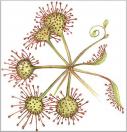Common Sundew - Drosera rotundifolia
This is a small carnivorous plant, with a rosette of round, long-stalked leaves. The upper side of the slightly concave leaf is covered with reddish hairs, which are much longer round the edges of the leaf than in the centre.
Each hair ends in a tiny, swollen gland which secretes a sticky shiny liquid like dew (in Greek “drosos” means dew), capable of attracting and catching minute invertebrates.
It flowers from May to July August. Once the prey is stuck, the sensitive peripheral hairs fold over like tiny tentacles and trap the victim completely.
Subsequently, the protease containing enzymes secreted by the hair glands "digest" the proteins so they can be absorbed. The floral scape carries a composite inflorescence of a few small flowers with five white petals.
The Common Sundew lives in bogs and marshes poor in nutrients, on bare peat and in acid soils; more often, as occurs at Sibolla and Massaciuccoli, it is slightly rooted in mosses.
Once it was reported in many localities in the Po Valley but is now extinct there; it now has a punctiform distribution in the peat bogs of the Alps and northern Apennines and must be considered a rarity.
The wetlands of northern Tuscany, where it occurs as an ice-age relict, are now the southern limit of its distribution in Italy.




